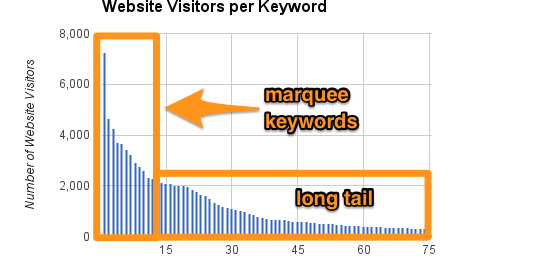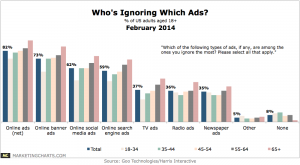Unless your company is undergoing an identity crisis, the core of your website — your homepage, your product, and “about us” pages — should be pretty static. Your blog, on the other hand, is where your brand’s content and keyword arsenal builds and diversifies.
Across digital marketing channels, your brand’s blog content functions like a shop-window: Offer something timely and eye-catching and you may just make a visitor interested enough to step inside and take a look around.
Not convinced you need to spruce up your brand’s window display? TrackMaven’s comprehensive report on the state of content marketing includes evidence that there’s a big opportunity for brand to capitalize on their blogs, some of which we’ll share below.
Why blog in the first place?
Because blogging is still a core competency for marketers.
The percentage of marketers utilizing a company blog as a marketing tactic is certainly on the rise. Eighty-one percent of B2B marketers and 77 percent of B2C marketers report using a blog as a content marketing tactic, both up five percent since 2014. But just because more people are blogging doesn’t mean you should start cranking out more content — or that everyone is doing it well.
In recent TrackMaven research, we actually found that there was a dip in the output of blogs per brand across 2015. The findings are presented in the summary graph below, which depicts the average number of social shares per blog post per brand (red) and number of blog posts per month per brand (blue).

In contrast to our findings on engagement with social content [link], the average number of blogs per brand per month actually decreased by 16 percent across the year to a low of 58. The average number of social shares per blog post per brand, however, held steady across the year, even climbing slightly to a peak of 190.7 average social shares per post in July 2015. In short: brands blogged less, but got more engagement overall.
So what does that mean for your brand? These findings signify the value of blogging efficiency — or lean blogging — in the marketing universe. In fact, among the 22,957 brands we analyzed, we identified many top-performing brands that reflected this trend of lean blogging: publishing fewer posts with higher impact that drive greater social engagement overall.
Here are three of those top-performing lean blogs that revved up their content marketing efficiency and brand value across 2015; by creating the right content, they drove major surges in their average social shares per post across 2015.
Three lean blogs (and what you can learn from them)
1. The Motley Fool
- Blog: Fool.com
- Why it’s a lean blog: In 2015, it published just over 17 thousand blog posts in 2015 that drove three billion social shares. That’s 176,000 social shares per blog post on average. Unless you’re a publisher trying to keep up with BuzzFeed, that’s a blog engagement metric to aspire to.
- Most engaging post: Better Dividend Stock: AbbVie or Johnson & Johnson? (14.5 million social shares and counting)
- Why it’s an effective post: It puts a competitive spin on an esoteric financial topic (top-tier dividend stocks).
2. InsightSquared
- Blog: Ramp, The InsightSquared Blog
- Why it’s a lean blog:
- Most engaging post: 8 Things The Top 1% Of Sales Reps Do Differently (3.4 thousand social shares and counting)
- Why it’s an effective post: It’s both aspirational (calling to the top 1 percent of sales reps) and actionable (offering eight emulate-able traits of top performing sales representatives).
3. Cato Institute
- Blog: Cato at Liberty
- Why it’s a lean blog: From January to December 2015, Cato cut the number of blog posts per month in half but reaped 400 times more blog social shares per month.
- Most engaging post: Syrian Refugees Don’t Pose a Serious Security Threat (75 thousand social shares and counting)
- Why it’s an effective post: It takes a definitive stance on a timely, controversial topic.
Still not inspired to resuscitate your blog? Here are five more ways that efficient blogging contributes to marketing performance:
1) Fresh blog content fuels your distribution platforms.
The blog is the collaborative keystone between content creators and social media managers. The consistent delivery of quality blog content fuels your brand’s social accounts with fresh content. It’s a beautiful symbiosis, really. To paraphrase A Field of Dreams, “Write it, distribute it, and they will come.”
At TrackMaven, we analyzed a sample of 1.2 million brand-generated blog posts and found that Facebook likes and shares account for the majority of blog interactions.
There’s also a reason social share buttons are a mainstay of every legitimate blog: If your content is deemed valuable, visitors can spread your brand’s gospel themselves with a simple click of a button.
2) Your blog keeps your brand fresh in the eyes of search engines.
Every time you write a blog post you’re adding one more indexed page under your brand umbrella in the eyes of Google and its Search Engine Brethren. That means you’ve increased your odds of showing up in search engine results. (And if you picked a high-intent keyword for your brand, that could boost your inbound lead generation).
3) Blogging extends the keyword tail for your brand.
The keyword profile for most brand websites (i.e. not publishers) looks something like the graph below, with a handful of (most likely) brand-related keywords that drive a high volume of traffic to your website, and a long tail of keywords that each drive lower traffic.
For the TrackMaven website, for example, “trackmaven” and “track maven” are among the brand-related search terms driving high traffic volume to our website. The keywords in the “long tail,” however, are typically categorically linked to your industry at large (but not your specific brand). But don’t underestimate the long tail of search. Added together, they have a significant cumulative impact. And the more you blog, the more keywords you’re adding to your keyword tail.
4) Blogging tees up high-impact calls-to-action.
A well-crafted blog post will provide valuable insight on a topic, but leave the reader wanting more. That’s where the call-to-action (CTA) comes in. If you have an ebook, whitepaper, event, newsletter subscription, or product offering that appropriately pairs with your blog subject matter, make sure to plug it. Take a look at the CTAs featured in the blogs we highlighted above for inspiration. [Hint: The InsightSquared post has FOUR CTAs in that one blog post.]
5) Blogging fuels your newsletter and email marketing campaigns.
Most brands can’t count on visitors navigating directly to their blog and finding each new piece of content on their own. That’s why email marketing — along with RSS-aggregators like Flipboard and Feedly — exist.That’s also where a brand’s newsletter comes in! An email marketing strategy can repurpose blog content to service your contact database in a newsletter.
Want more insights into the latest content marketing trends? Get your copy of TrackMaven’s latest ebook, The Content Marketing Paradox Revisited.
Digital & Social Articles on Business 2 Community
(35)






